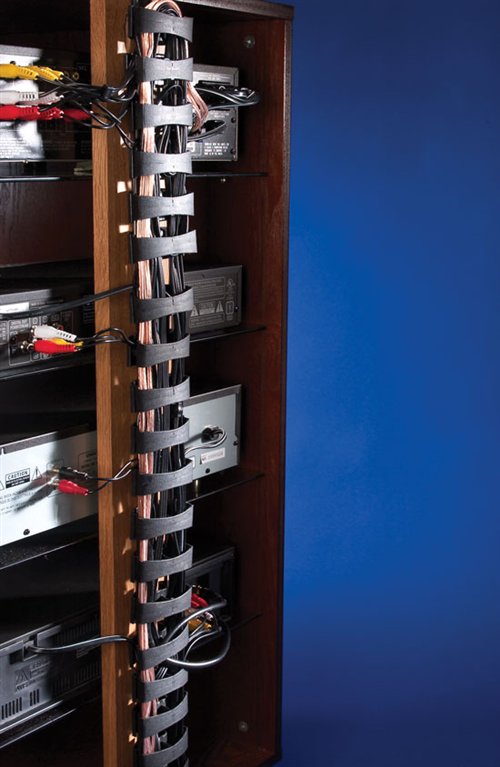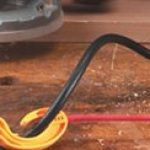We may receive a commission when you use our affiliate links. However, this does not impact our recommendations.
Electric spaghetti. That’s what most of us have lurking behind our computer desks and entertainment centers. Every time you want to add or take out a component, unsnarling that mess can be a real nightmare.
There’s a term for the solution: wire management. The best new cabinets and desks have built-in wire-management features, such as raceways and concealing panels, to route wires. Other much simpler ways exist to manage wires, however; they’re especially useful to retrofit less-sophisticated furniture, old or new. Here are nine of our favorite methods.
Mouse Trap
One cord in particular always seems to tangle: the tail of a computer’s mouse. Two wire clips are the answer. Mount one at the back of your keyboard tray, the other at the back of the desk. The mouse won’t slide off the tray, and the cord won’t wrap around your legs. |
WireMate
Here’s a slick way to organize and conceal extra wire. The WireMate has three sets of cleats for separating and looping slack wire. Each cleat is split in the middle, which makes it even easier to wrap up just the right amount of wire. A cover snaps on to hide the stuff inside. |
Spiral Wrap
This simple, inexpensive product binds wires together. You can pull them in or let them out anywhere along the length of the bundle. Spiral Wrap is simply a tube cut in a helical pattern. To install it, pull your wires in a taut line and wind the wrap around them. It only takes a few minutes. Spiral Wrap comes in various diameters to accommodate as many wires as you have. |
Vertebrae
No, it’s not a set of bones; it’s a series of plastic clips in a plastic channel. But it resembles a spine so much that it’s dubbed The Vertebrae. You can run wires in and out as needed between each clip. That’s perfect for a stacked set of components, but you can position it horizontally, too. Run a couple of screws through the plastic channel to fasten it in place wherever you need it. As you organize and loop your wires, just snap each vertebra shut. There’s plenty of room inside for lots of slack |
Homemade Cleats
This cord-wrapping device is just a set of wooden knobs bought at the hardware store. Drill a screw hole through the center of each knob to make mounting easier. Mount them as far apart as you want to minimize the number of loops. Then use hook-and-loop wire wraps to secure the wires (see page 38). Coat hooks and clothesline cleats also work well. No doubt there’s something in your junk drawer that’ll do the job, too. |
Centralize the Power Source
Plug all your gear into a single power center and label each component. Mount the power center on the back of your desk or cabinet, out of sight. After you’ve taken the slack out of your wires, direct all of them to this central hub.
If you’re hooking up computer equipment, buy a power center that has a surge protector with receptacles for both the computer’s power cord and the telephone line for its modem. This model even has coaxial cable connections. When shopping for a surge protector, keep a few basics in mind. It should have a UL rating and be listed as a transient voltage surge suppressor. The voltage at which it kicks in should be low, 330 volts or less. It should have an indicator light to let you know that it is not just functioning as an extension cord. It should have high energy absorption, at least 200 to 400 joules, and a response time of less than 1 nanosecond.
The labels we used have hook-and-loop fasteners, so all you need to do is pinch them in place. They’re just as easy to remove and reuse.
|
Wire Wraps
Hook-and-loop wire wraps are so easy to use that you can tie up your slack in seconds. Of course, they’re also very inexpensive. Wraps are available in many sizes to handle any situation. |
Cable Turtle
Who thinks of this clever stuff? Here’s a split hollow ball with a spool inside for wrapping small-diameter wire. Pop open the Cable Turtle to turn both halves inside out, wrap your wire around the middle and snap the halves shut. Easy! It’s ideal for speaker and telephone wire and it looks cool enough to sit on your desktop. |
This story originally appeared in American Woodworker October 2005, issue #117.
Source information may have changed since the original publication date.
Sources
Cable Organizer.com Inc., (877) 547-4580, www.cableorganizer.com Grommet, #GR-2375, $4.50 ea. Wire clips are available at home centers and hardware stores. WireMate.com, (212) 867-6020, www.wiremate.com The WireMate, #WMG (gray), #WMB (black), #WMW (white), $30 ea.M.M. Newman Corp., (800) 777-6309, www.mmnewman.com Spiral Wrap, #HT3/4C, $17 for 25 ft. Doug Mockett & Co. Inc., (800) 523-1269, www.mockett.com The Vertebrae, #WM15A, $13. CableOrganizer.com Inc., (877) 547-4580, www.cableorganizer.com Quick Pinch labels, QP001-4, $6 for eight. Power centers with surge suppressors are available at electronics stores and home centers. CableOrganizer.com Inc., (877) 547-4580, www.cableorganizer.com Wire wraps, #VWOW-PK, $2.50 for five. CableOrganizer.com Inc., (877) 547-4580, www.cableorganizer.com Cable Turtle, #CT-LG, $8.

Here are some supplies and tools we find essential in our everyday work around the shop. We may receive a commission from sales referred by our links; however, we have carefully selected these products for their usefulness and quality.


















